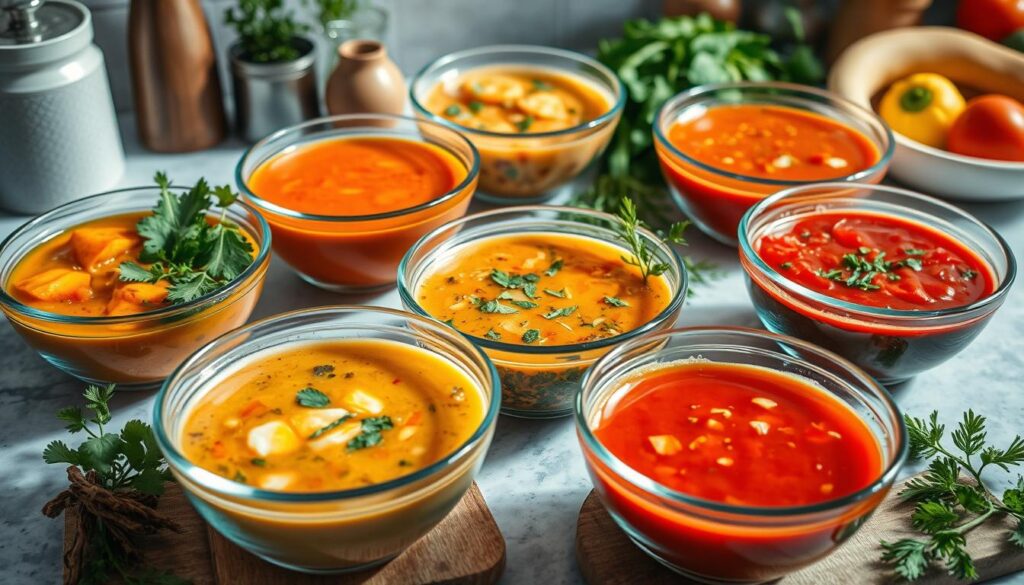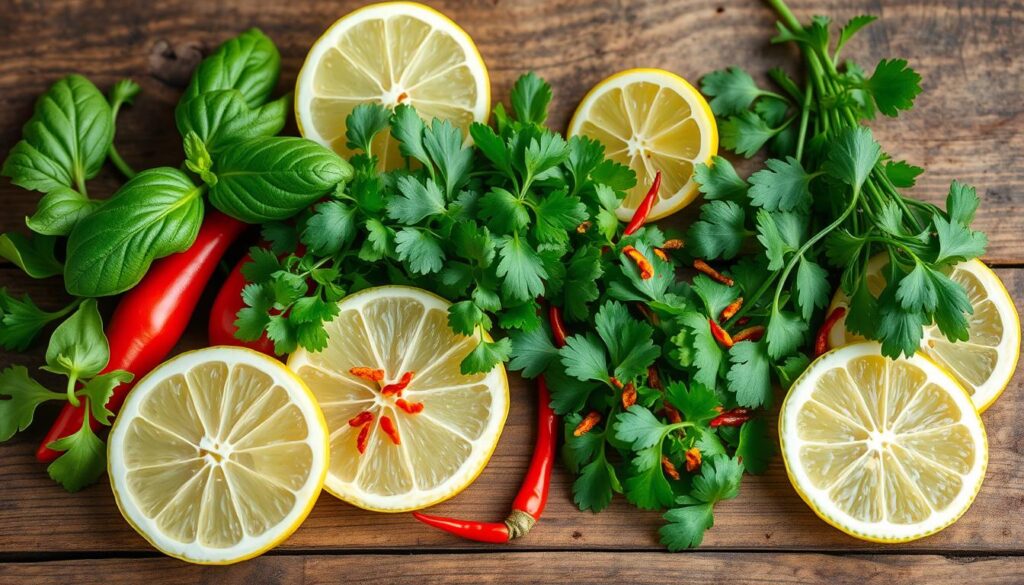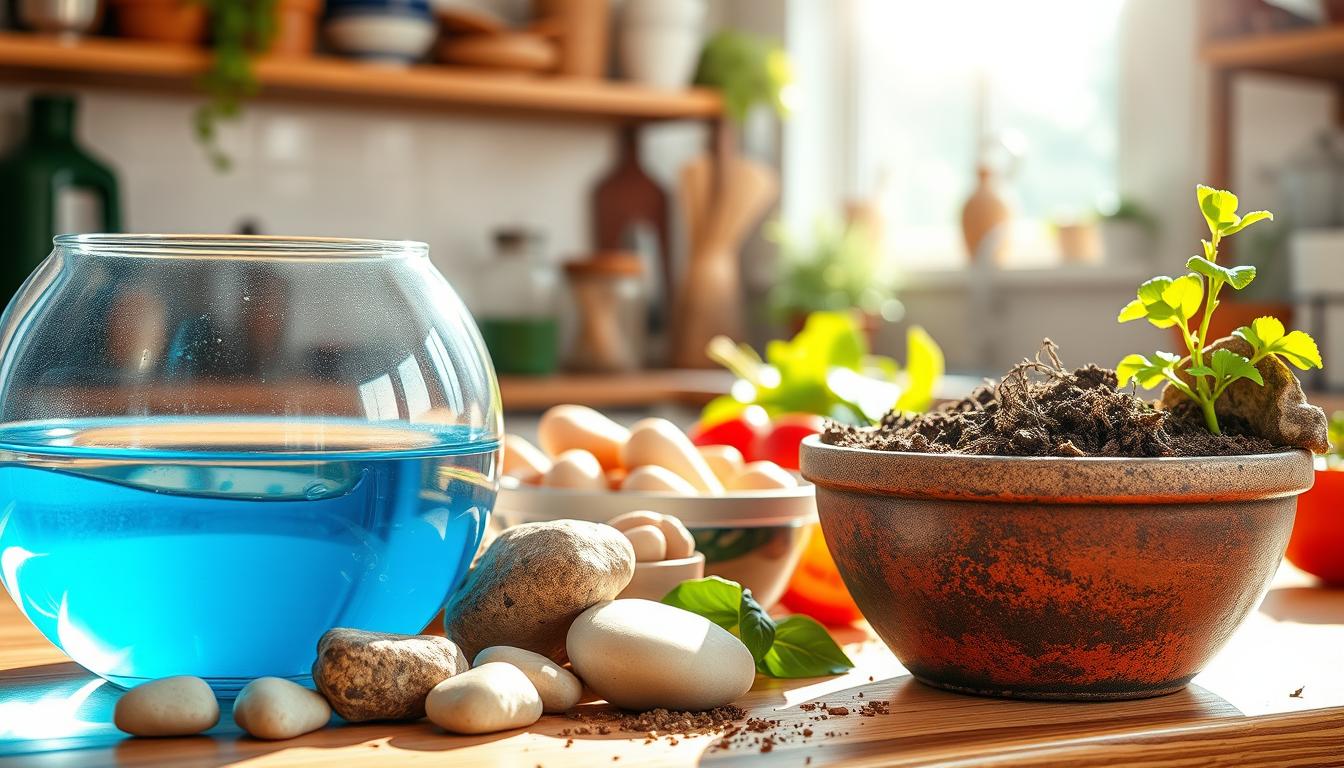As the sun sets, the evening air gets chilly. Nothing warms you up like a hearty soup. But in Abiotic Factor, your cooking is more than just food. It shows the world around you.
Imagine making soups that not only fill your belly but also help your in-game character. They can boost your strength, speed, and more. These abiotic factor soup recipes are more than food. They open new doors and help you thrive in Abiotic Factor.
Table of Contents
Key Takeaways
- Discover a unique blend of environmental conditions recipes that offer various in-game benefits.
- Learn how to create non-living ingredient soups using a Portable Stove, Cooking Pot, and Water.
- Explore a wide range of soup variations, each with its own distinct effects and restoration values.
- Understand the importance of cooking skill levels in determining food quality and restoration.
- Discover the strategic advantages of incorporating Abiotic Factor soups into your gameplay.
What are Abiotic Factors in Cooking?
In cooking, abiotic factors are non-living things that affect ingredients and how we prepare them. Things like temperature, water quality, and altitude are key. They shape the taste, texture, and look of our dishes, including climate impact dishes, ecological factor cuisine, and inorganic element broths.
Understanding Ingredients and Their Environment
The quality and availability of ingredients depend on their environment. Soil minerals, water pH, and local climate affect vegetables, herbs, and spices. Chefs can choose the best ingredients and recipes by knowing these abiotic factors.
The Role of Temperature in Soup Preparation
Temperature is very important in making soups. The right cooking temperature can turn a thin broth into a rich, flavorful inorganic element broth. It also affects how ingredients mix and how the soup feels in your mouth.
“Embracing the abiotic factors that shape our ingredients is the key to creating climate impact dishes that are not only delicious but also sustainable and in harmony with the natural world.”
By using these abiotic factors, chefs can make soups that are tasty and show off the ecological factor cuisine of their area. This way, we celebrate the connection between nature and cooking.
Why Choose Abiotic Factor Soups?
Abiotic factor soups are a great choice for meals. They are made with an eye on how weather, geology, and atmosphere affect ingredients. This makes them a unique and healthy option.
Nutritional Benefits
These soups are packed with nutrients. They use local and sustainable ingredients. For example, vegetable broths from fresh, local produce add flavor and vitamins.
By choosing plant-based cooking, these soups are tasty and eco-friendly.
Easy to Customize for Dietary Needs
Abiotic factor soups are easy to adjust for different diets. They can be tailored to fit various dietary needs. This is thanks to understanding how weather influence meals, geological component stews, and atmospheric composition bowls work.
This makes them perfect for those looking for healthy, personalized meals.
“By blending abiotic factors like UV-B radiation and nutrient availability with flavors, cooks can create unique and flavorful soups that are good for both health and the environment.”
Choosing abiotic factor soups boosts nutrition and flexibility. It also promotes sustainable cooking. Whether you’re a pro chef or a home cook, exploring abiotic factor soups can lead to creative and eco-friendly meals.
Essential Ingredients for Your Soup
Creating tasty non-living ingredient soups is all about using a wide range of environmental conditions recipes. From simple veggies to complex herbs and spices, each adds something special. They shape the flavor, texture, and health benefits of your soup.
Vegetables: The Foundation of Flavor
Vegetables are the heart of any non-living ingredient soup. Ingredients like tomatoes, potatoes, and peas are key. They add unique tastes and important nutrients like vitamins, minerals, and fiber.
- Tomatoes: Add a burst of tangy, acidic goodness to your soups.
- Potatoes: Provide a creamy, starchy base that helps thicken your soup.
- Peas: Offer a sweet, fresh flavor and a pop of vibrant color.
Herbs and Spices to Enhance Taste
Take your environmental conditions recipes to the next level with herbs and spices. Rosemary’s earthy scent and black pepper’s zesty kick can turn a basic soup into a work of art.
- Salt: The quintessential seasoning that brings out the natural flavors of your ingredients.
- Garlic: Adds a savory, pungent note that complements a wide range of soups.
- Thyme: Imparts a fragrant, slightly minty flavor that pairs well with many vegetables.
Try mixing different herbs and spices to find the perfect mix. This will make your non-living ingredient soups truly come alive.
Popular Abiotic Factor Soup Recipes
Soup recipes are key in Abiotic Factor for players looking for nourishment and benefits. You’ll find everything from vegetable soups to bean and lentil dishes. These recipes help players tackle the game’s challenges.
Classic Vegetable Soup Recipe
The Classic Vegetable Soup is a favorite among players. It’s made with water, super tomatoes, and a bit of salt. The fresh veggies add nutrients and a great texture.
Hearty Bean and Lentil Soup
The Hearty Bean and Lentil Soup is perfect for those who want something filling. It includes water, Exor Heart, Carbunkle Mushroom, and Super Tomato. This soup not only fills you up but also offers various benefits.
But, be careful with certain soups like Poop Soup or Toxic Soup. They can make you sick or even kill you in the game. By choosing the right ingredients and cooking methods, you can make soups that are both tasty and beneficial.
| Soup Recipe | Hunger Effect | Thirst Effect | Other Effects |
|---|---|---|---|
| Meaty Stew | 40 | 22 | – |
| Pest Goulash | 30 | 10 | – |
| Bland Pea Soup | 20 | 20 | Raises Sprinting and Sneaking XP |
| Sustenance Soup | 20 | 20 | Quick Reflexes, increased Accuracy and Reload XP |
| Simple Tomato Soup | 15 | 35 | – |
| Toxic Soup | 15 | 10 | Causes sickness |
| Poop Soup | 0 | 3 | Causes death |
| Killer Soup | 10 | 15 | Causes death |
Tips for Perfecting Your Soup
Making the perfect ecological factor cuisine or inorgenic element broths is more than just mixing ingredients. It’s about getting the right consistency and balancing flavors for the best taste. This will make your soup stand out.
Achieving the Right Consistency
The consistency of your soup is key. Adjust the liquid-to-ingredient ratio to get it just right. Start with broth or water, then add more or less to reach your texture goal. Try different ratios to find what you like best.
Balancing Flavors for Optimal Taste
Think of soup recipes as a symphony of flavors. You need to blend them well. Mix aromatic vegetables, herbs, and spices to layer the taste. Use salt carefully to boost the flavor without overdoing it. Taste your soup often and adjust as needed for the perfect flavor balance.
By paying attention to these two important areas, you’ll make ecological factor cuisine and inorgenic element broths that are not only healthy but also delicious.
Cooking Techniques for Abiotic Soups
Mastering different cooking techniques is essential for making delicious abiotic factor soups. Whether you like the quick stovetop method or the easy slow cooker way, there’s a technique for everyone. It fits your lifestyle and taste.
Stovetop Recipes for Quick Meals
The stovetop is perfect for fast, healthy soup making. With a Portable Stove and Cooking Pot, you can quickly mix ingredients. This creates tasty soups that fill you up.
By reaching a Cooking Level of 3, you can try out many soup recipes. This lets you match your soup to your taste and the weather.
Slow Cooker Options for Convenience
The slow cooker is great for those who want to make soup without much effort. It lets you simmer ingredients while you do other things. The slow heat makes your soup’s flavors and textures better.
Choosing your cooking method, you can explore the world of abiotic factor soups. Understanding temperature, water, and seasonal ingredients helps. You can make soups that are good for you and show the natural world’s beauty.

Creative Add-Ins for Extra Nutrition
Make your atmospheric composition bowls and soups better with creative add-ins. Add protein-rich meats and legumes, or colorful vegetables. These ingredients make your soup a healthy and tasty meal.
Protein Boosters: Meats and Legumes
Use lean meats like Peccary Chop or Alien Drumstick for a protein boost. These add depth and richness to your soup. For a plant-based option, try kidney beans, lentils, or chickpeas. They make your soup balanced and delicious for vegetarians or vegans.
Colorful Vegetables: Bringing Life to Your Soup
Add vibrant vegetables to make your soups look and taste better. Super Tomatoes add color and important vitamins. Leafy greens, root vegetables, or cruciferous options also boost nutrition and flavor.
| Ingredient | Nutritional Benefits | Culinary Applications |
|---|---|---|
| Peccary Chop | High in protein, iron, and B vitamins | Adds heartiness and depth to soups and stews |
| Alien Drumstick | Rich in protein, phosphorus, and selenium | Provides a unique, savory flavor to non-living ingredient soups |
| Super Tomatoes | Packed with vitamins A, C, and E, as well as lycopene | Enhances the color and nutrient profile of atmospheric composition bowls |
| Kidney Beans | High in fiber, folate, and plant-based protein | Adds texture and heartiness to vegetarian and vegan soups |
Adding protein boosters and colorful vegetables turns your soups into nutritious and beautiful dishes. They nourish your body and delight your senses.
Storing and Reheating Your Soups
Storing and reheating your soups right is key to keeping them tasty. Whether it’s a simple veggie soup or a hearty bean and lentil soup, the right steps help keep the flavor and nutrients in. This way, you can enjoy your soups again and again.
Best Practices for Storage
To keep your soups fresh for later, here’s what to do:
- Put cooled soup in airtight containers or resealable bags.
- Make sure there’s some space in the container for it to expand when it freezes.
- Keep soups in the fridge for up to 4 days or freeze for up to 3 months.
- Don’t store soups with things like dairy or fresh herbs for too long. They can lose their taste and texture.
Reheating Without Losing Flavor
When you’re ready to eat your soups again, heat them gently to keep the taste and texture:
- Let frozen soups thaw in the fridge overnight before heating.
- Warm soups on the stovetop over medium heat, stirring now and then, until they’re hot.
- Don’t microwave soups. It can heat them unevenly and lose flavor.
- If you’re reheating them a few times, remember to follow food safety rules to avoid bacteria.
By storing and reheating your soups the right way, you can enjoy their delicious flavors again and again.
Serving Suggestions
Make your climate impact dishes and ecological factor cuisine stand out with great serving ideas. Serve your Abiotic Factor soups with breads and salads for a complete meal. Adding fresh herbs or a dollop of cream not only looks good but also adds class.
Pairing Soups with Breads and Salads
Bread is a perfect match for soup, adding a nice contrast in texture and temperature. Try serving your Abiotic Factor soups with artisanal breads, warm rolls, or whole-grain toast. For a bigger meal, add a fresh, crisp salad with local, seasonal produce.
Garnishing for Visual Appeal
- Sprinkle freshly chopped herbs, such as parsley, chives, or basil, to add a vibrant pop of color and heighten the aroma.
- Drizzle a swirl of creamy yogurt or a dollop of sour cream to create a visually appealing contrast.
- Garnish with a sprinkle of toasted nuts or seeds for added crunch and texture.
- Slice up fresh vegetables, like radishes, carrots, or bell peppers, for a colorful and crunchy topping.
With these easy serving tips, you can take your Abiotic Factor soup dishes to the next level. They’ll look inviting and celebrate the climate impact dishes and ecological factor cuisine you’ve made.

Common Mistakes to Avoid
When making inorganic element broths, it’s key to avoid common mistakes. These can ruin the flavor and health benefits of your soups. Overcooking and not simmering long enough are two big mistakes.
Overcooking the Ingredients
One big error in making soup is overcooking veggies and other important parts. It’s important to cook them well, but too long can lose nutrients and flavor. Always check the cooking time in your recipe and adjust to keep the broth’s quality.
Skipping the Simmering Time
Another mistake is rushing the simmering. This can stop your Abiotic Factor soups from being their best. Letting ingredients simmer as suggested helps flavors mix well. Skipping this can make your meals taste flat and lacking.
By avoiding these mistakes and following recipes well, you’ll make tasty and healthy Abiotic Factor soups. They will please your taste buds and help your body.
“Patience is a key ingredient when simmering the perfect Abiotic Factor soup. Don’t rush the process, and you’ll be rewarded with a truly remarkable culinary experience.”
Exploring Global Flavor Profiles
Start your journey into abiotic factor soups and discover new flavors from around the world. From the Mediterranean’s warm herbs to Asia’s deep umami, your soups can take you on a global food adventure.
Mediterranean Inspirations
Bring the Mediterranean to your soups with olive oil, garlic, and herbs. This region’s soups mix tomatoes, white beans, and leafy greens in a tasty broth. Top it off with olive oil and fresh herbs for a Mediterranean touch.
Asian-Inspired Soup Variations
Dive into Asia’s atmospheric composition bowls with soy sauce, miso, and ginger. Try bok choy, shiitake mushrooms, and rice noodles for a flavorful Asian soup. These soups will excite your taste buds with their unique flavors.
Exploring global flavors means trying new things. In games, use Exor Heart or Carbunkle Mushroom for unique tastes. The world of abiotic factor soups is full of possibilities, taking you to different places with every spoonful.
Conclusion: Your Soup Adventure Awaits
As you’ve learned, non-living ingredient soups open up a world of flavors. By using the special qualities of Abiotic Factor ingredients, you can make soups that are both tasty and healthy. These soups can feed your body and lift your spirit.
Embrace Your Culinary Creativity
Start your Abiotic Factor soup adventure by trying new ingredients and cooking methods. Let your creativity shine in the kitchen. The unique qualities of non-living elements can lead to amazing flavor mixes. Don’t be afraid to try new things and find exciting tastes.
Share Your Favorite Recipes with Friends
Keep sharing your favorite Abiotic Factor soups with friends and family. Whether it’s a simple veggie soup or a rich bean and lentil stew, your cooking can bring people together. Sharing your love for these dishes can start interesting talks and build a community of food lovers.
FAQ
What are abiotic factors in cooking?
Abiotic factors in cooking are non-living things that affect how we cook. For example, temperature is key in making soup. It changes how long we cook and how ingredients mix.
What are the benefits of abiotic factor soups?
Abiotic factor soups are good for you and can be made in many ways. They can give you health boosts like more energy or better stamina. They also let you use ingredients that fit your diet and the weather.
What are the essential ingredients for abiotic factor soups?
Key ingredients for these soups are veggies like tomatoes and peas. They give the soup its taste. Herbs and spices like salt add flavor. In games, special ingredients like Exor Heart can be used too.
What are some popular abiotic factor soup recipes?
Some favorite soups include Simple Tomato Soup and Hearty Stew. These soups can slow down hunger or boost your XP gain. They also have special effects.
How can you perfect your abiotic factor soup?
To make your soup better, get the right mix of ingredients. Use salt wisely to balance the taste. In games, try new ingredients to find cool effects.
What cooking techniques are used for abiotic factor soups?
You can cook these soups on the stovetop or in a slow cooker. In games, use a Portable Stove. Reaching Cooking Level 3 lets you make soups. Real-life cooking methods can fit your schedule.
How can you enhance abiotic factor soups with creative add-ins?
Add protein like meats or legumes for more nutrition. Colorful veggies like Super Tomatoes add taste and vitamins. In games, these add-ins can give special benefits.
How should you store and reheat abiotic factor soups?
Keep soups fresh by storing them right and reheating them gently. In games, be careful not to lose your soup. In real life, use airtight containers and gentle heat.
What common mistakes should you avoid when preparing abiotic factor soups?
Don’t overcook your soup to keep nutrients and flavor. Also, make sure to simmer long enough. In games, wrong ingredients can make bad soups.
How can you explore global flavor profiles in abiotic factor soups?
Try different flavors like Mediterranean or Asian in your soups. Use ingredients like olive oil or soy sauce. In games, unique ingredients can create new tastes and effects.

